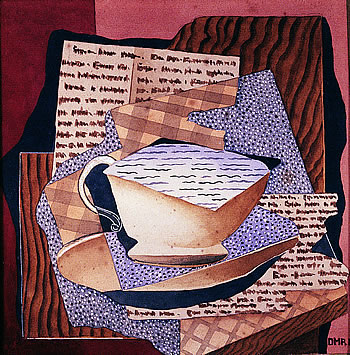
Bodegón con taza, 1915
Temple sobre papel 21,5 x 21,5 cm.
Colección del Gobierno del Estado de Veracruz
La naturaleza muerta
En esta serie de naturalezas muertas se puede apreciar principalmente la escuela cubista. Diego Rivera tuvo una producción cubista de primer orden, entre retratos, naturalezas muertas y paisajes, donde crearía una galería envidiable de posibilidades, incluso hasta el hecho mismo de incrustar motivos mexicanos en una modalidad que sólo parecía permitir detalles europeos. Dentro del grupo de naturalezas muertas en esta colección, resaltan la obra inacabada de 1918 que contiene, entre otros, jarra, tazón e instrumento para hacer puré de papas; y la discutida naturaleza muerta cézanniana que divide las opiniones entre si fue pintada en 1908 o en 1918. En ésta obra la influencia de Cézanne es notoria y también se puede vislumbrar el genio de Rivera en sus primeros momentos del aprendizaje pictórico.
En Naturaleza muerta con botella, de 1914, experimenta con nuevas técnicas propias del cubismo: el collage y el papier collé, que le sirven para llegar por diferentes vías a la aprehensión de la realidad. Por una parte, la representación de la botella por medio del diseño cubista lo lleva a un acercamiento teórico y conceptual de la realidad, y por otra, la aplicación del papel tapiz y de la nota lo hacen llevar la realidad externa y empírica en el interior del cuadro. Dos formas que siempre se habían considerado opuestas, aquí conviven mostrando la nueva mirada del mundo a principios del siglo XX.
In this series of still lifes the cubist school can be appreciated. Diego Rivera had a cubist production of first order, including portraits, still lifes and landscapes; he would create an enviable gallery of possibilities, he even included Mexican motifs in a modality that seemed to allow only European details. Within the group of still lifes in this collection, we have to emphasize the unfinished work of 1918 that contains, among others, jar, bowl and instrument; and the discussed cézannian still life that divides the opinions: were it painted in 1908 or in 1918?. In this work the influence of Cézanne is evident and also it is possible to see the genius of Rivera in the first moments of his pictorial learning. In Still life with bottle, of 1914, he experiments with the new techniques of the cubism: collage and papier collé, that allows him to represent by different ways the apprehension of the reality. On the one hand, the representation of the bottle by cubist design media takes him to a theoretical and conceptual approach of the reality; on the other hand, the application of the carpet and the note makes him take the external and empirical reality in the interior of the panel. Two forms that always had been considered opposed, coexist here showing the new glance of the world at the beginning of XXth century.